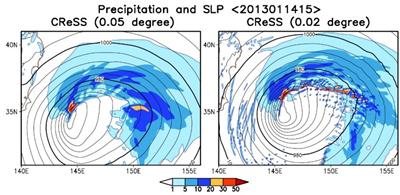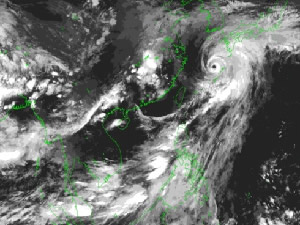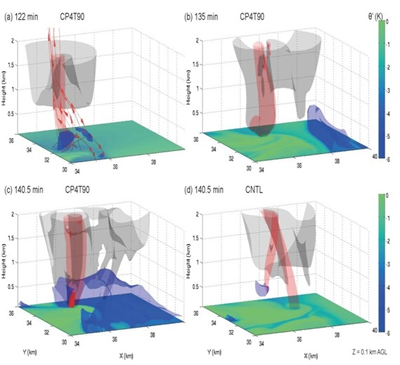
HOME / Departments / Earth and Planetary Sciences / Meteorology and Climate Dynamics
Meteorology and Climate Dynamics
-
- KAWAMURA Ryuichi, Professor
- MOCHIZUKI Takashi, Associate Professor
- KAWANO Tetsuya, Assistant Professor
- Meteorology and Climate Dynamics Laboratory (MCDL) has a long history at Kyushu University, encompassing a broad range of observational, theoretical and numerical-experimental research on dynamic meteorology and climate system. The MCDL highlights fundamental issues of cloud physics, mesoscale and synoptic meteorology, large-scale dynamical processes in the atmosphere, and ocean and climate dynamics. We also pay particular attention to the mechanisms of severe local storm, tropical cyclone and winter storm to contribute to disaster reduction in Monsoon Asia. The following topics are part of recent work from MCDL.
1. Rapid intensification of winter storm
It is well known that explosively developing extratropical cyclones frequently appear over the northwestern Pacific Ocean and the northwestern Atlantic Ocean during boreal winter. More recently, we highlighted an explosive cyclone migrating along the southern periphery of the Kuroshio/Kuroshio Extension in January 2013 and investigated the manner in which vapor evaporating from the warm currents influences the rapid growth of the cyclone. We stressed that active roles of the cold conveyor belt (CCB) were key factors in the explosive development of the cyclone over warm currents. The CCB is a low-level easterly flow with cold and dry air that prevails along the northern side of the cyclone's center. The CCB plays a vital role not only in stimulating surface evaporation from the warm currents but also in importing the evaporated vapor into the vicinity of the cyclone's center. The imported moisture converges at the bent-back front within the cyclone system and induces latent heat release, eventually accelerating the cyclone's development. The cyclone's deepening further intensifies the CCB. We suggested that this positive feedback process leads to rapid intensification of cyclones over warm currents.

We are also trying to reproduce the mesoscale structure in winter storm, together with the Japan Agency for Marine-Earth Science and Technology (JAMSTEC). Using the Earth Simulator of JAMSTEC, we are able to perform very high-resolution simulations with a horizontal scale of about 2 km. We expect that such a study contributes a great deal to proper understanding of the developing mechanism of the winter storm and the associated severe local storm.
2. Development and maintenance of tropical cyclone via moisture conveyor belt

The role of remote ocean sea surface temperature (SST) in regulating tropical cyclone (TC) characteristics has been examined by performing numerical experiments with a regional scale model. Model simulations have been carried out to simulate typhoon Man-yi (July 2007), in our case study, under a range of SST conditions over the Indian Ocean and the South China Sea. The intensity and track of the cyclone have been systematically changed in sensitivity simulations of cool and warm SSTs over that region, following its peak phase. Warm oceans can substantially reduce the intensification of western North Pacific cyclones, whereas cool oceans can enhance their strength. This is intimately associated with the enhancement/weakening of the moisture supply through the moisture conveyor belt (MCB) in the lower troposphere, from the Indian Ocean and South China Sea into the vicinity of the cyclone center. When the MCB is interrupted over the South China Sea in warm SST occurrences, the large-scale transport of moisture into the cyclone system is significantly reduced, leading to the weakening of the cyclone intensity and to the eastward shift of its track. This study shows that changes in remote tropical ocean SST can also modulate TCs and thus can help in improving the forecasting of TC intensities and tracks.
3. Numerical simulation of supercell tornadogenesis

A tornado is one of the most violent meteorological phenomena causing fatal damage. Most strong tornadoes are spawned by supercells, which are cumulonimbi with a strong vertical vortex. Tornadogenesis in association with supercells, however, is not completely understood. We focused on the interaction between a supercell and an outflow boundary, which is often made by a preexisting cumulonimbus, because many tornadoes occur in the vicinity of outflow boundaries.
To investigate tornadogenesis related to the interaction, we performed numerical simulations. As a highly idealized outflow boundary approached a developed supercell having a strong surface vortex, the surface vortex in the supercell markedly intensified. This intensification was associated with the enhancement of the near-surface horizontal convergence by the outflow boundary.
4. Videosonde observations of snow clouds on the Japan Sea side of central Japan

Videosondes, which are balloon-borne equipment that can measure sizes and electric charges of each precipitation particle in cloud, are very useful for understanding precipitation processes. We carried out observation campaigns with videosondes in the Hokuriku district in winter, collaborating with Central Research Institute of Electric Power Industry and Yamaguchi University and are trying to clarify precipitation processes in wintertime Hokuriku snow clouds through a detailed analysis of the videosonde observations.
5. Global climate variability and predictability
Precise and reliable information of future climate is required for socioeconomic policy making such as disaster prevention and mitigation. Near-term climate prediction beyond the time scales of season recently represents a new and tough challenge, by synthesizing numerical model and observational records in a similar manner to the weather forecasting. We have evaluated prediction skills with uncertainty estimation in actual prediction calculations of climate variability such as El Niño events, the Pacific Decadal Oscillation, and the Atlantic Multidecadal Oscillation. In addition to the aim of understanding the predictability, we are also furthering our understanding of the atmosphere and ocean coupled mechanisms of these phenomena and their interactions across the oceans.